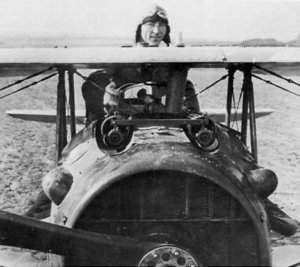Eddie Rickenbacker
|
|
Edward Vernon (Eddie) Rickenbacker (October 8, 1890-July 27, 1973) was an American fighter pilot who flew in World War I. He was born Edward Rickenbacher in Columbus, Ohio to Swiss immigrants.
| Contents |
Early life
Rickenbacker_1904.jpg
In 1904, Rickenbacker's father, William, was killed at a construction site. Rickenbacker quit school immediately to work to support his family, working mostly industrial jobs. The last of these, working in a Pennsylvania Railroad machine shop, led him to pursue a career in the automobile industry. By 1910, Rickenbacker was racing his employers' cars, placing 10th in the 1914 Indianapolis race in a Duesenberg and in 1917, he went to England, intending to start the 1917 racing season in that country. When he got to England, rather than race, he enlisted in the U.S. Army.
World War I
Rickenbacker arrived in France on June 26, 1917. Given a rank of sergeant first-class, he was assigned as staff driver for Colonel William Mitchell. Interested in aviation, Rickenbacker was accepted into the Army Air Corps, and in March 1918, he was assigned to the 94th Aero Pursuit Squadron, the first all-American air unit to see combat duty in World War I. He flew Nieuport 28 and SPAD XIII aircraft. On April 20, 1918, he shot down his first plane. A notable adversary was the vaunted Flying Circus commanded by the Red Baron, Manfred von Richthofen.
Initially disliked by his squadron mates, many of whom had degrees from prestigious colleges, his respect grew as his kills mounted. Rickenbacker won the French Croix de Guerre in May 1918 by shooting down five German airplanes. On September 24, 1918, he was named commander of the squadron, and on the following day he shot down two more German planes, for which he was awarded the Congressional Medal of Honor, belatedly, in 1931. The most successful American ace left alive, the press dubbed him America's "Ace of Aces." He claimed his 26th and final plane on October 30, 1918, 12 days before the end of the war.
His 26 victories was an American record that stood until World War II. In the 1970s the Air Force reduced the number to 24.33, taking account of shared victories, and normalizing WW I scores with those in WW II. While the US Air Service credited "out of control" and other nonfatal victories, in terms of aircraft destroyed, Rickenbacker's tally was six airplanes and two balloons plus two balloons on the ground. He flew a total of 300 combat hours, more than any other U.S. pilot in the war.
Template:Multi-video start Template:Multi-video item Template:Multi-video end
Post-War
After World War I ended, Rickenbacker started an automobile company (see: Rickenbacker), selling technologically advanced cars, but the company was financially unsuccessful. In 1927, he bought the Indianapolis Speedway, which he would operate for nearly a decade and a half before closing it down during World War II. Unable to afford to rehabilitate it after the war, he sold it in 1947. Rickenbacker later worked for the Cadillac division of General Motors and various aircraft manufacturers and airlines.
In 1922, Rickenbacker married Adelaide Frost. Their marriage would last the rest of his life. They adopted two sons: David, in 1925, and William, in 1928.
World War II
Initially opposed to entering World War II, Rickenbacker supported the war effort once the United States committed to entry. In 1942, he toured training bases in the southwestern United States and in England. In October 1942, he was sent on a tour of the Pacific theater. After visiting bases in Hawaii, the B-17 Rickenbacker was flying in went off course hundreds of miles from its first scheduled stop at Canton Island. The pilot ditched the plane in the Pacific.
The crew's food supply ran out after three days. On the eighth day a seagull landed on Rickenbacker's head. The bird became dinner and fishing bait. The Army Air Corps, unable to find them, intended to abandon the lost crew after searching unsuccessfully for more than two weeks, but Rickenbacker's wife convinced them to extend the search another week.
Navy pilots rescued the crew, suffering from exposure, dehydration and starvation, on November 13, 1942. They had been lost 24 days.
Post-World War II
In 1938, Rickenbacker had bought Eastern Airlines. Immediately after World War II, Eastern became the first airline to purchase and operate the Lockheed Constellation and was, for a time, the most profitable airline in the post-war era. In the late 1950s, Eastern's fortunes changed, and Rickenbacker was forced out of his CEO position on October 1, 1959. He left his position as chairman of the board December 31, 1963.
In the 1960s, Rickenbacker became a well-known conservative speaker. He died in 1973 in Zürich, Switzerland. He is buried in Columbus, Ohio. In 1974, the Lockbourne Air Force Base in his home of Columbus was renamed Rickenbacker Air Force Base.
External links
- The Rickenbacker Papers at Auburn University (http://www.lib.auburn.edu/archive/flyhy/101/eddie.htm)
- Biography for Aviation History magazine (http://history1900s.about.com/library/prm/blrickenbacker1.htm)
- Entry from Webster's American Military Biographies (http://www.allstar.fiu.edu/aerojava/rickenbacker2.htm)de:Edward Vernon Rickenbacker


